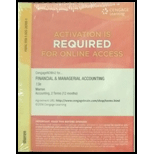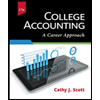
(a)
Note receivable:
Note receivable refers to a written promise received by the creditor from the debtor in formal, for the amounts to be settled within a stipulated period of time. This written promise is issued by a debtor or borrower to the lender or creditor. Notes receivable is an asset of a business. Notes receivable often used for the credit periods of more than 60 days.
Due date:
Due date is the maturity date on note, on due date the borrower is supposed to repay the face value of the note along with interest.
The due date for the note received on July 12.
(b)
The maturity value of the note.
(c)
To journalize: The entry to record the receipt of the payment of the note at maturity.
Want to see the full answer?
Check out a sample textbook solution
Chapter 8 Solutions
CengageNOWv2, 2 terms Printed Access Card for Warren?s Financial & Managerial Accounting, 13th, 13th Edition
- How can I solve this financial accounting problem using the appropriate financial process?arrow_forwardCan you provide a detailed solution to this financial accounting problem using proper principles?arrow_forwardPlease provide the accurate answer to this general accounting problem using valid techniques.arrow_forward
- Can you help me solve this financial accounting problem with the correct methodology?arrow_forwardPlease provide the accurate answer to this financial accounting problem using appropriate methods.arrow_forwardI need assistance with this financial accounting question using appropriate principles.arrow_forward
- Can you solve this financial accounting problem using appropriate financial principles?arrow_forwardI am looking for the correct answer to this financial accounting question with appropriate explanations.arrow_forwardPlease help me solve this financial accounting problem with the correct financial process.arrow_forward
- Principles of Accounting Volume 1AccountingISBN:9781947172685Author:OpenStaxPublisher:OpenStax College
 College Accounting (Book Only): A Career ApproachAccountingISBN:9781337280570Author:Scott, Cathy J.Publisher:South-Western College Pub
College Accounting (Book Only): A Career ApproachAccountingISBN:9781337280570Author:Scott, Cathy J.Publisher:South-Western College Pub College Accounting, Chapters 1-27AccountingISBN:9781337794756Author:HEINTZ, James A.Publisher:Cengage Learning,
College Accounting, Chapters 1-27AccountingISBN:9781337794756Author:HEINTZ, James A.Publisher:Cengage Learning,  Intermediate Accounting: Reporting And AnalysisAccountingISBN:9781337788281Author:James M. Wahlen, Jefferson P. Jones, Donald PagachPublisher:Cengage LearningCentury 21 Accounting Multicolumn JournalAccountingISBN:9781337679503Author:GilbertsonPublisher:Cengage
Intermediate Accounting: Reporting And AnalysisAccountingISBN:9781337788281Author:James M. Wahlen, Jefferson P. Jones, Donald PagachPublisher:Cengage LearningCentury 21 Accounting Multicolumn JournalAccountingISBN:9781337679503Author:GilbertsonPublisher:Cengage





